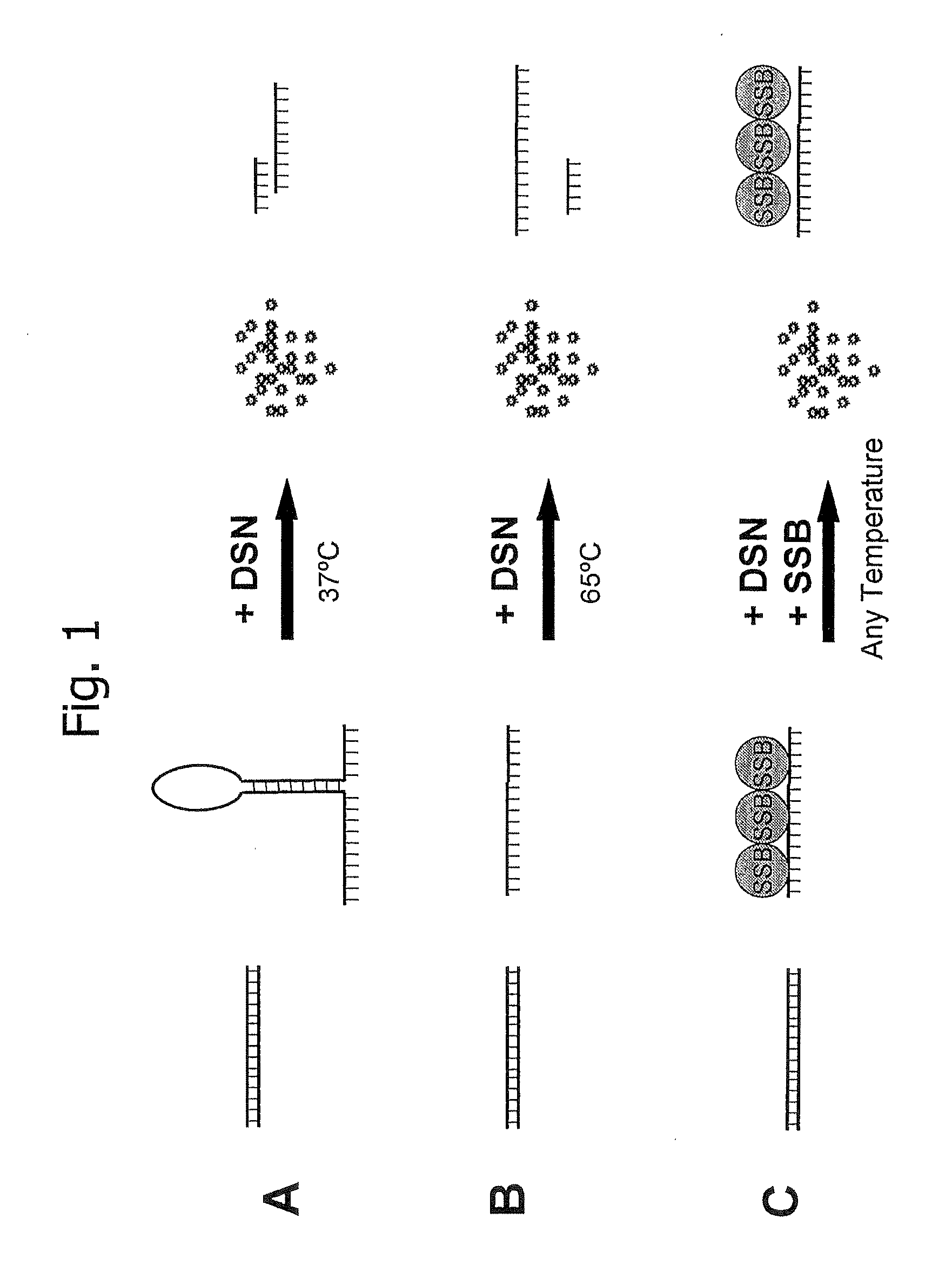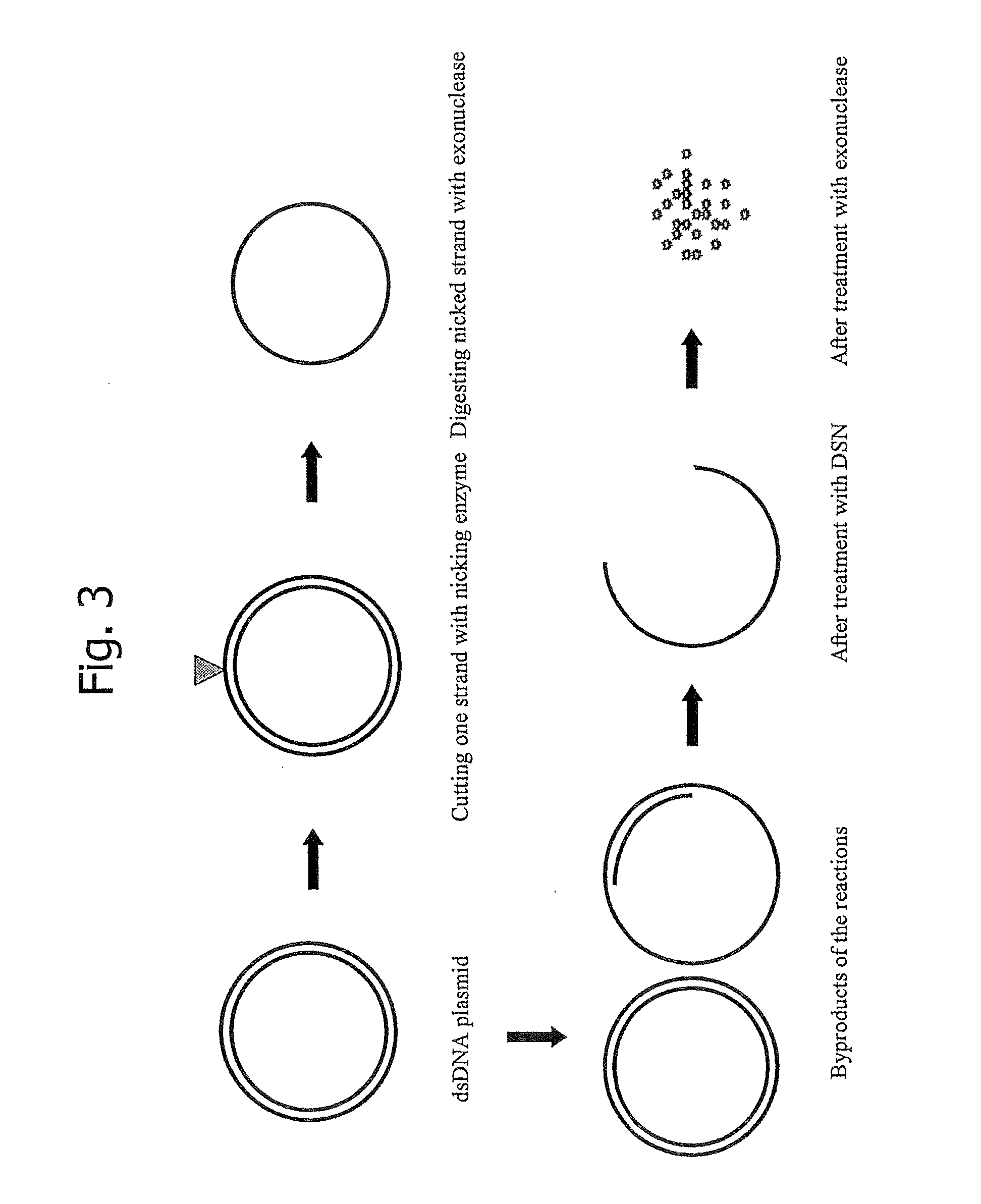Method for preparing single-stranded DNA
a single-stranded dna and dna technology, applied in the field of single-stranded dna preparation, can solve the problems of tedious and complicated purification of single-stranded dna, limited approach, and inability to obtain single-stranded dna by means of this approach, etc., to achieve fast, effective, reliable, robust and easy-to-reach effects
- Summary
- Abstract
- Description
- Claims
- Application Information
AI Technical Summary
Benefits of technology
Problems solved by technology
Method used
Image
Examples
example 1
[0092] Template DNA for the preparation of single-stranded DNA can be circular or linear RNA or DNA, already single-stranded or double-stranded by nature, and can be obtained, prepared or modified by any method known to a person skilled in the art. Thus, the invention is not limited to the use of a particular source of DNA or RNA.
[0093] For the purpose of this example, a cDNA library prepared from a melanoma cell culture and cloned into the vector system Lambda-FLC, disclosed in patent application PCT / JP02 / 01667, which is hereby incorporated herein by reference, was used to perform the invention. From an aliquot of the aforementioned cDNA library, plasmid DNA was isolated by standard protocols as described by P. Carninci et al. in Genomics Vol. 77, 2001, pages 79-90, which is hereby incorporated herein by reference. The plurality of plasmid DNA obtained was characterized by digestion with the restriction endonuclease PvuII to measure the size of the cDNA inserts by gel electrophore...
example 2
[0100] Activity of DSN against single-stranded DNA was tested by the use of radioactively labeled single-stranded DNA prepared from the aforementioned library G2 as a sample. Sample DNA was labeled with □P32-GTP (Amersham Biosciences, Cardiff, United Kingdom) as described in “DNA Micorarrays: A Molecular Cloning Manual”, edited by D. Bowtell et al., Cold Spring Harbor Laboratory Press, 2003, which is hereby incorporated herein by reference. In this example the effect of different single-stranded-DNA binding substances was tested, and they were compared for the effect on DSN activity as well as the protection of the single-stranded DNA. To perform the experiment, the radioactive sample was divided into four equal aliquots each of which contained 250 ng of single-stranded DNA in 7 μl of water plus 1 μl of 10x DSN Buffer (Evrogen, Cat.# EA001, Moscow, Russia). After heat treatment of the samples at 65° C. for 5 min, the following reactions were performed in a final volume 10 μl: First,...
example 3
[0101] Activity of DSN against linear single-stranded DNA was tested by the use of radioactively labeled liner single-stranded DNA prepared from the aforementioned G2 mRNA sample. Linear single-stranded DNA was synthesized and labeled with □P32-GTP (Amersham Biosciences, Cardiff, United Kingdom) as described in “DNA Micorarrays: A Molecular Cloning Manual”, edited by D. Bowtell et al., Cold Spring Harbor Laboratory Press, 2003, which is hereby incorporated herein by reference. After heat treatment of the samples at 65° C. for 5 min, reactions were performed as disclosed in Example 2 using 0.25 unit of DSN (Evrogen, Cat.# EA001, Moscow, Russia), and 1 μl of E.coli protein SSB (Promega, Madison, USA, Cat. No. M3011) were indicated. After incubation at 37° C. or 65° C. for 1 h, the reactions were terminated and the samples were mixed with 3 μl of alkaline loading buffer for gel electrophoresis (300 mM NaOH, 30 mM EDTA, 30% glycerol, 0.2% Brome Phenol Blue). Afterwards samples were load...
PUM
| Property | Measurement | Unit |
|---|---|---|
| Secondary structure | aaaaa | aaaaa |
Abstract
Description
Claims
Application Information
 Login to View More
Login to View More - R&D
- Intellectual Property
- Life Sciences
- Materials
- Tech Scout
- Unparalleled Data Quality
- Higher Quality Content
- 60% Fewer Hallucinations
Browse by: Latest US Patents, China's latest patents, Technical Efficacy Thesaurus, Application Domain, Technology Topic, Popular Technical Reports.
© 2025 PatSnap. All rights reserved.Legal|Privacy policy|Modern Slavery Act Transparency Statement|Sitemap|About US| Contact US: help@patsnap.com



